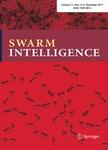版权所有:内蒙古大学图书馆 技术提供:维普资讯• 智图
内蒙古自治区呼和浩特市赛罕区大学西街235号 邮编: 010021

作者机构:Arizona State Univ Sch Comp Informat & Decis Syst Engn Tempe AZ 85281 USA Arizona State Univ Sch Sustainabil Tempe AZ 85281 USA Arizona State Univ Sch Complex Adapt Syst Tempe AZ 85281 USA Arizona State Univ BEYOND Ctr Fundamental Concepts Sci Tempe AZ 85281 USA Arizona State Univ Sch Life Sci Tempe AZ 85281 USA Arizona State Univ Sch Earth & Space Explorat Tempe AZ USA
出 版 物:《SWARM INTELLIGENCE》 (群集智能)
年 卷 期:2021年第15卷第1-2期
页 面:171-203页
核心收录:
学科分类:0710[理学-生物学] 07[理学] 0701[理学-数学] 0811[工学-控制科学与工程] 071002[理学-动物学] 0812[工学-计算机科学与技术(可授工学、理学学位)]
主 题:Quorum sensing Collective decision making Bio-inspired Cognition Multi-agent systems Multi-robot systems Swarms Distributed robot systems
摘 要:Quorum sensing (QS) is ubiquitous in distributed, multi-agent systems in nature-from bacteria to arthropods to primates-and has been proposed as a useful distributed algorithm in engineered systems-from multi-robot systems to Internet server farms. Achieving QS requires groups to collectively integrate information about their numbers and reach consensus on an action contingent upon those numbers. In nest-site selection tasks that employ QS in ants, sensitivity to encounter rate has been implicated as a mechanism for how individuals sense that quorum has been reached. However, little is known about how individual ants estimate proximity to the critical rate. Ant-inspired QS algorithms proposed by computer scientists either heavily depend on communication between agents or the ability for individual agents to accumulate information over many encounters with others. Both communication and significant memory storage may be beyond the simple capabilities of small-scale robots in large collectives. Alternatively, if cognition was embodied across the group of agents and their physical environment, cognitive abilities could far exceed the abilities of each individual. Toward this end, we propose a novel bio-inspired algorithm for QS on mobile agents within a confined space. Our approach does not require individuals to communicate or count over long sequences of encounters;instead, QS emerges from the random interaction of mobile excitable agents with each other and the physical cavity. We validate theoretical predictions for our algorithm s performance in simulation, and we also show that it has good qualitative agreement with accuracy and response-time data from real ants. More broadly, our algorithm provides a new, concrete example of how ants can serve as conceptual models for hypothetical dynamic networks of mobile neurons.